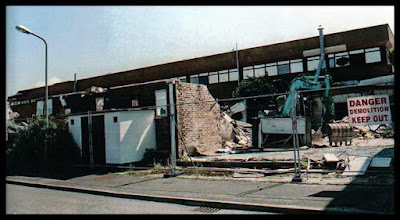Continuing from the last three posts, I found that I had so many photos from two further visits that I decided to make a Part Four. After demolition huge piles of building materials and other odd remains were left on site, so I went to have a look and found that they'd left quite a few interesting things, some of which I hadn't seen during my earlier explores.
Oddly enough, although most of the benches had been left intact, this one had been ripped apart with the concrete uprights left in situ. The shelter also still remained as it was, along with the litter boxes and trees.
And an oil tank, which I hadn't photographed on my earlier visits.
I also saw some more bird feeders that I hadn't noticed before.
What is sad though, is that a couple of weeks later all the trees were chopped down. I didn't revisit the site after that but I did take some photos from the lane side through the fence a couple of years ago...shown further down at the end.
Looking from the site towards the boat builder's yard on the spit of land jutting out into the river, above. The river was at low tide on each visit so that I could access the ledge and scramble up the bank without getting wet feet...or falling into the river! Hooray for Tide Tables. :)
Various steel wires were left dangling above ground.
The bricks and other detritus were left piled up at each end of the site.
Missed a bit! An odd brick corner, below.
And two from a couple of years ago when I went down to see what had happened to the pigeon lofts. The fence mostly gone, and nature has once again taken over the surrounds with buddlea, other garden escapees and lots of wild flowers.
The bank by the river is really quite a lot higher now and overgrown. I was going to have another meander down there to see what has happened since, but unable to do so before finishing this, so I'll add something another time when I have the opportunity.
I hope you enjoyed this little foray into the story of Racal Electronics and its last days. Please stay safe everyone during these difficult times. Hopefully I'll be getting more stuff uploaded now - I left a lot of the more involved, longer and time-consuming rewrites from my website, which is why I've slowed down with posting articles - but I've still got plenty to go and hopefully a bit more frequently too. :)


















































































